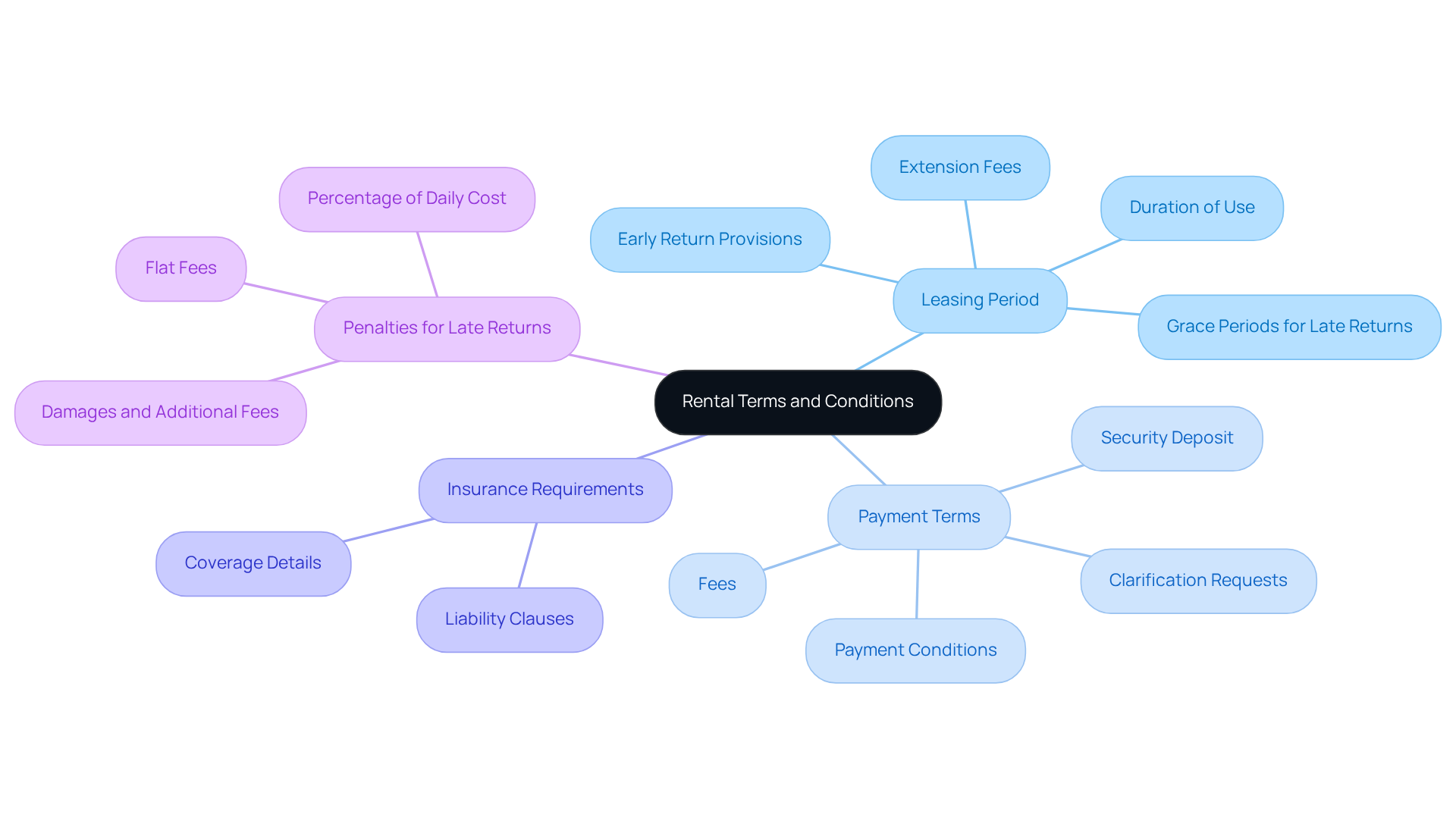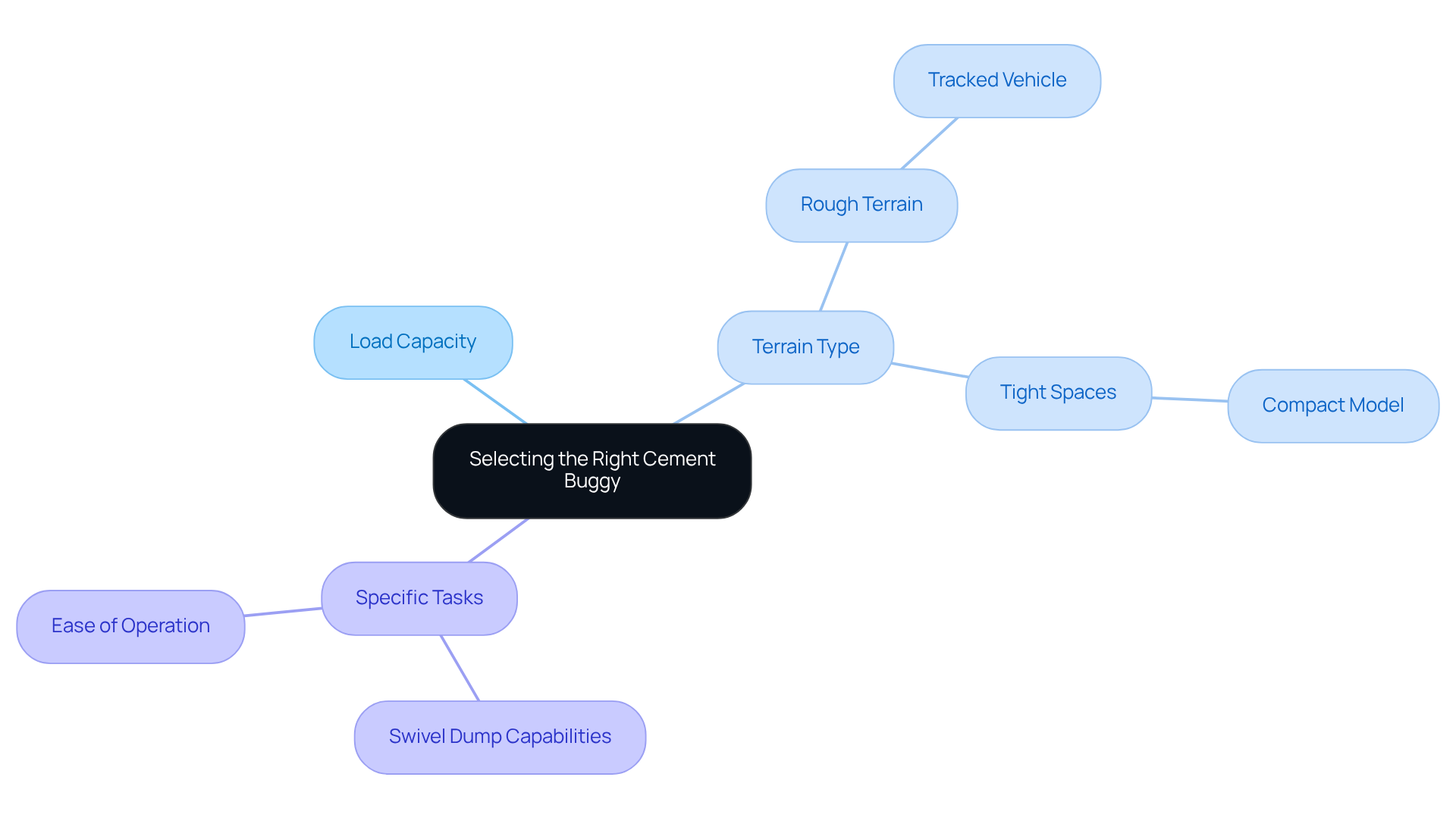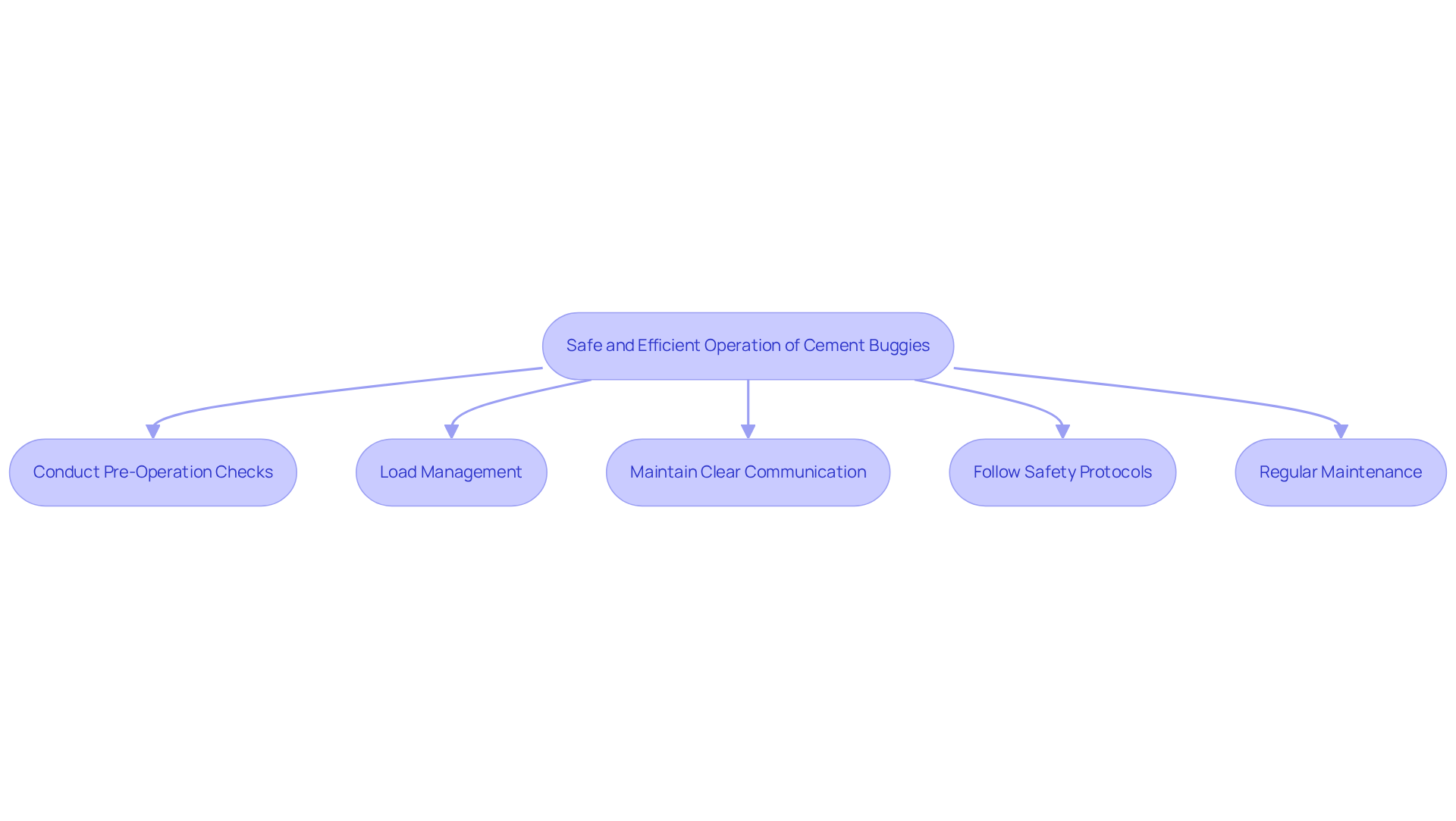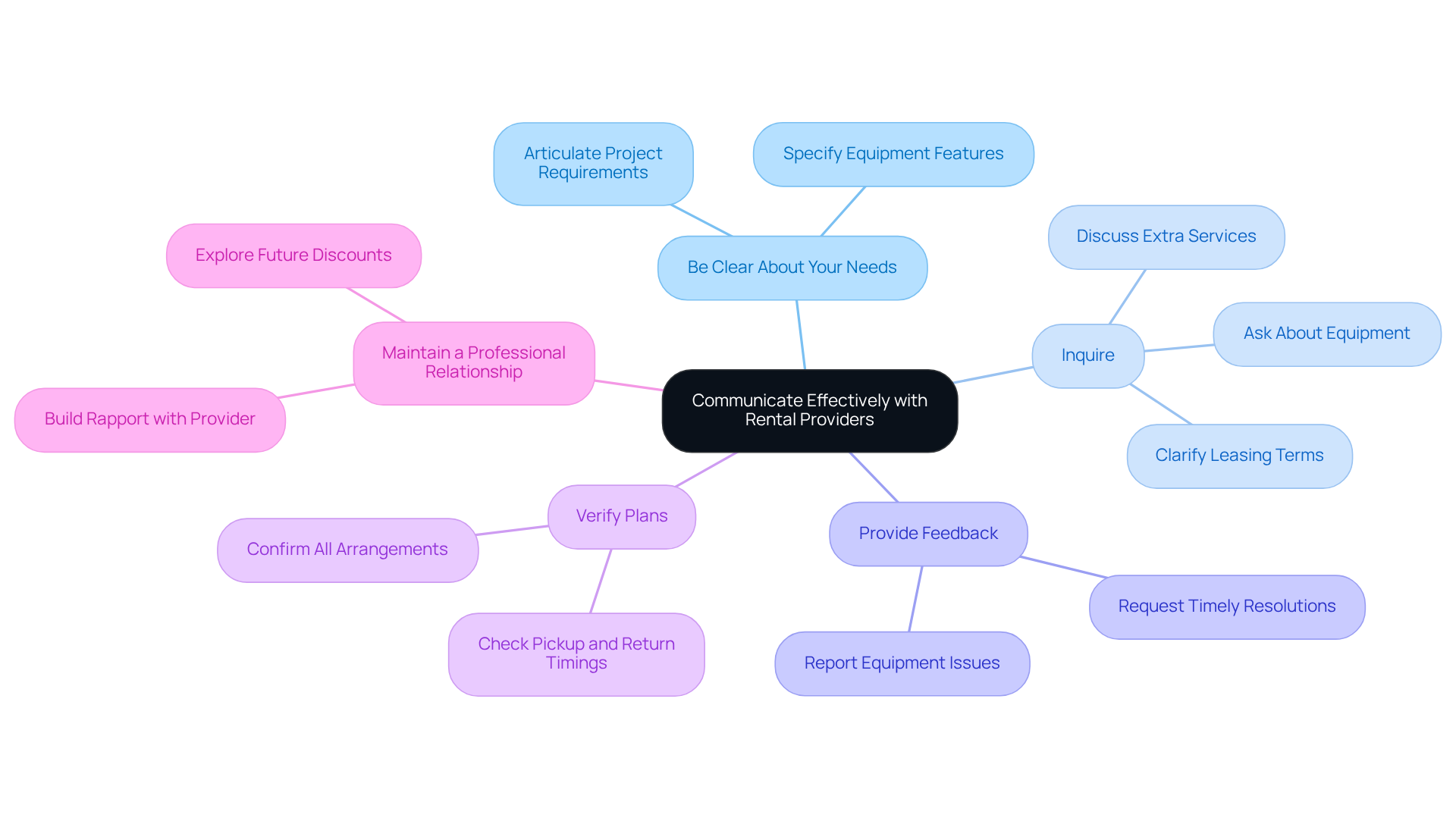Overview
This article highlights four essential practices for successful cement buggy rental:
- Understanding rental terms
- Selecting the appropriate buggy
- Implementing safety measures
- Maintaining effective communication with rental providers
These practices are crucial as they help avoid unexpected costs, ensure the right equipment is utilized for specific tasks, promote safe operation, and foster a positive relationship with providers. Ultimately, these elements lead to a more efficient rental experience, making it imperative for users to engage with these guidelines.
Key Highlights:
- Review rental agreements carefully, focusing on leasing period, payment terms, insurance, and penalties for late returns.
- Exceeding the agreed leasing period can incur extra charges; clarify responsibilities to avoid unforeseen expenses.
- Include essential contract elements such as identification of parties, item description, duration, fees, and security deposit.
- Monthly rental agreements for cement buggies can be more cost-effective than hourly or daily rates.
- Consider load capacity, terrain type, and specific project tasks when selecting a cement buggy.
- Conduct pre-operation checks on the vehicle to ensure safety and functionality before use.
- Manage loads evenly and maintain control to prevent tipping; maximum allowable grade for operation is 10%.
- Effective communication with team members reduces accident risks; use hand signals or radios in noisy environments.
- Follow safety protocols and ensure operators are trained in safe operating procedures.
- Adhere to the manufacturer's maintenance schedule to enhance safety and reduce breakdowns.
- Establish clear communication with rental providers by articulating project needs and verifying plans to avoid complications.
- Building a professional relationship with rental providers can lead to better service and potential discounts.
Introduction
Navigating the world of cement buggy rentals can be a daunting task, particularly given the myriad of options and varying terms across providers. Understanding the nuances of rental agreements and selecting the right equipment are crucial steps that can significantly impact project efficiency and costs. What essential practices can ensure a seamless rental experience while avoiding unexpected expenses and operational challenges? This article delves into four key practices that not only simplify the rental process but also enhance safety and efficiency on the job site.
Understand Rental Terms and Conditions
Before opting for a cement buggy rental, it is essential to carefully examine the agreement and conditions. Focus on key aspects such as:
- The leasing period
- Payment terms
- Insurance requirements
- Penalties for late returns
Surpassing the agreed leasing period can result in extra charges, significantly impacting your budget. Numerous leasing firms impose penalties that can vary from a flat fee to a percentage of the cost for each day the equipment is overdue. Furthermore, damages sustained during the lease period may also lead to additional fees, highlighting the importance of clear communication about responsibilities. To prevent unforeseen expenses, always request clarification on any unclear phrases before signing the agreement. Understanding these specifics not only guarantees adherence to the lease agreement but also safeguards your interests throughout the leasing process.
Incorporating important aspects in the contract, such as:
- Identification of parties
- Description of items
- Duration of use
- Fees
- Payment conditions
- Security deposit
is vital to prevent misunderstandings. Additionally, recording the state of the equipment prior to leasing can avoid conflicts regarding damages. Consider that monthly agreements for cement buggy rental can save more than 50% compared to hourly or daily rates, making it financially beneficial to thoroughly understand the rental terms.

Select the Right Cement Buggy for Your Project
When selecting a cement cart, it is crucial to consider factors such as load capacity, terrain type, and the specific tasks at hand. For instance, if your project involves transporting heavy loads over rough terrain, a tracked vehicle may prove to be more suitable than a wheeled option. Furthermore, evaluate the vehicle's features, including swivel dump capabilities and ease of operation.
Consulting with rental providers regarding your project requirements can significantly aid in choosing the most appropriate cement buggy rental for your needs. For example, if navigating tight spaces is essential, a compact model may be necessary.

Implement Best Practices for Safe and Efficient Operation
To operate a cement buggy safely and efficiently, it is essential to adhere to best practices that ensure both safety and effectiveness.
-
Conduct Pre-Operation Checks: Before use, inspect the vehicle for visible damage, ensure all controls function properly, check fluid levels, and verify that guards and safety signs are in place. Daily pre-operational inspections are crucial, as they help identify potential issues that could lead to accidents or equipment failure.
-
Load Management: Distributing loads evenly is vital to maintaining stability and preventing tipping. The maximum allowable grade for operating a power vehicle with wheels is 10% (6°). Avoid exceeding the vehicle's specified capacity, and maintain control of speed and direction to ensure safe operation by avoiding sudden movements.
-
Maintain Clear Communication: Utilize hand signals or radios to communicate effectively with team members, especially in noisy environments. Effective communication significantly reduces the risk of accidents, as operators must remain aware of their surroundings and the positions of other workers.
-
Follow Safety Protocols: Always wear suitable personal protective gear (PPE) and ensure that all operators are trained in safe operating procedures. According to safety specialist Randy Wheelis, "When it involves handling larger machinery like power dump trucks, guaranteeing appropriate training and compliance with safety protocols is crucial."
-
Regular Maintenance: Adhere to the manufacturer's maintenance schedule to keep the vehicle in optimal working condition. Preventive maintenance can reduce breakdowns by 70% to 75%, ultimately saving costs and enhancing safety on the job site. Notably, aging equipment is identified as a leading cause of unplanned downtime by 44% of respondents, making regular maintenance essential for operational efficiency.
By applying these optimal methods, operators can greatly minimize the risk of accidents and guarantee the effective utilization of cement buggy rental vehicles on construction sites.

Communicate Effectively with Rental Providers
Establishing clear communication with your leasing provider significantly enhances your leasing experience. To achieve this, consider the following essential tips:
-
Be Clear About Your Needs: Clearly articulate your project requirements, including the type of work, expected duration, and any specific features you need in the cement buggy. This clarity sets the foundation for effective collaboration and ensures that your provider can meet your expectations.
-
Inquire: Don’t hesitate to ask questions regarding the apparatus, leasing terms, and any extra services provided, such as delivery and pickup. Engaging in this dialogue not only clarifies your understanding but also fosters a transparent relationship with your provider.
-
Provide Feedback: If you encounter any issues with the equipment, report them promptly to the supplier to ensure timely resolutions. This proactive approach can prevent minor issues from escalating and demonstrates your commitment to maintaining quality standards.
-
Verify Plans: Prior to the leasing period commencing, verify all plans, including pickup and return timings, to prevent any last-minute issues. This step is crucial to ensuring a smooth transition and avoiding unnecessary complications.
-
Maintain a Professional Relationship: Building a good rapport with your rental provider can lead to better service and potential discounts on future rentals. A strong professional relationship not only enhances your current experience but also opens doors for future opportunities.

Conclusion
Understanding the intricacies of cement buggy rental is crucial for ensuring a smooth and cost-effective experience. This article delves into four essential practices that enhance the rental process and safeguard against potential pitfalls. By focusing on:
- Rental terms
- Selecting the right equipment
- Implementing safe operational practices
- Fostering effective communication with rental providers
Users can optimize their cement buggy rental experience.
Key arguments highlighted include:
- The importance of comprehending rental agreements to avoid unexpected charges
- The necessity of choosing the right buggy based on project needs
- The implementation of best practices for safe operation
Furthermore, establishing clear communication with rental providers can lead to better service and a more favorable rental experience. These insights collectively empower users to make informed decisions that enhance efficiency and safety on the job site.
Ultimately, adopting these practices is not merely about following guidelines; it fosters a culture of safety and efficiency within construction operations. By prioritizing clear communication, understanding equipment needs, and adhering to safety protocols, individuals can significantly reduce risks and enhance productivity. Embracing these strategies will not only improve project outcomes but also contribute to long-term success in the construction industry.
Frequently Asked Questions
What should I examine before renting a cement buggy?
Before renting a cement buggy, you should carefully examine the rental agreement and conditions, focusing on the leasing period, payment terms, insurance requirements, and penalties for late returns.
What are the consequences of exceeding the agreed leasing period?
Surpassing the agreed leasing period can result in extra charges, which may significantly impact your budget. Penalties can vary from a flat fee to a percentage of the cost for each day the equipment is overdue.
What additional fees might I incur during the rental period?
Additional fees may apply for damages sustained during the lease period, so it is important to have clear communication about responsibilities and to clarify any unclear terms before signing the agreement.
What important aspects should be included in the rental contract?
The rental contract should include the identification of parties, description of items, duration of use, fees, payment conditions, and security deposit to prevent misunderstandings.
How can I avoid conflicts regarding damages to the equipment?
To avoid conflicts regarding damages, it is advisable to record the state of the equipment prior to leasing.
Are there cost advantages to different rental agreements?
Yes, monthly agreements for cement buggy rental can save more than 50% compared to hourly or daily rates, making it financially beneficial to understand the rental terms thoroughly.




